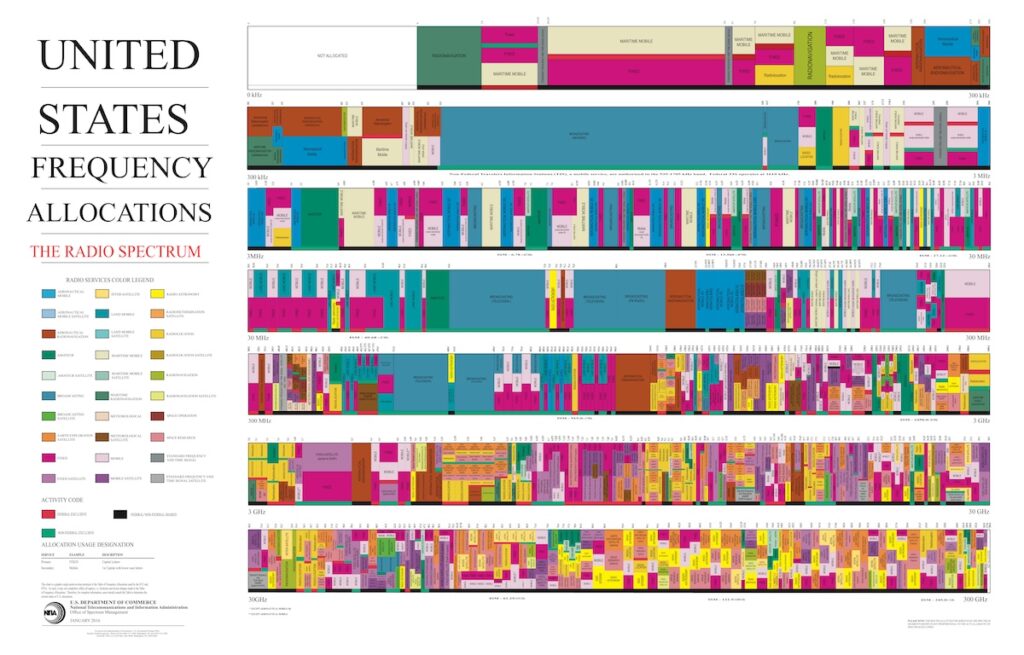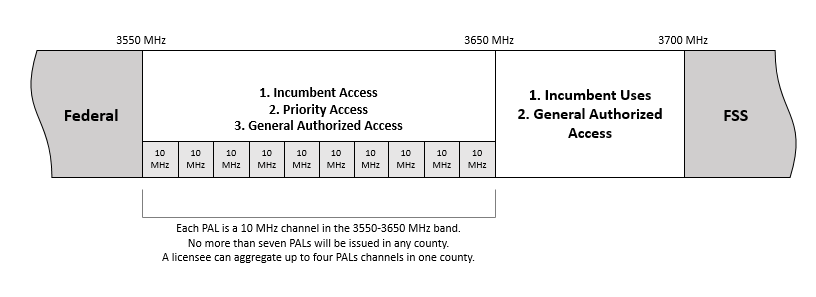I’m going to write about CBRS today, a band of electromagnetic spectrum in the U.S. that, thanks to the FCC, has been opened up and allowed for some real innovation.
If all you care about is making money from wireless mining, then this might not interest you, but here’s why I care.
Crypto fascinates me (and many others) because it combines so many technical and social fields — cryptography, computer science, economics, art, and psychology — to enable new models of human coordination.
Projects like Helium and Pollen add two new elements to the equation: devices devices that operate in physical space1 and the electromagnetic layer — radio waves moving through space and time to transmit and receive data between people and devices.
I’m not an expert in any of the above disciplines, I’m just a curious generalist trying to figure this stuff out, which is why my mind was blown last week when I started considering something that I’d always taken for granted — how the hell does data move through the air?
Like, when I connect my phone to Wi-Fi in my apartment, how does that data travel through the air and to my phone? Is it magic?
OK, it’s not magic. But it certainly feels like magic.
At some point I’ll take the time to try and grok the entire concept of wireless communications today I’m just going to wrap my head around a small piece of the electromagnetic spectrum, the band from 3.55 GHz to 3.70 GHz.
What is CBRS?
First of all, CBRS is not the same as CB or “Citizens Band” radio that truckers use to talk to each other2
CRBS stands for “Citizens Broadband Radio Service.” It refers to a specific slice of the electromagnetic spectrum, or more specifically, the radio spectrum.
The electromagnetic spectrum encompasses the waves that are all around us: visible light, x-rays, gamma rays, UV rays, TV and radio broadcasts, satellite transmissions, and many more.
The radio spectrum is a subset of the electromagnetic spectrum. Radio waves are waves with a frequency in the range from 3 Hz to 3,000 GHz (3 THz).
In the U.S., the radio spectrum is tightly regulated by the NTIA (federal uses) and the FCC (non-Federal uses). Those agencies have, in the past century or so, divided up the spectrum for a wide array of different uses — from military satellites to cell phones to TV broadcasts and of course, actual AM/FM radio.
It’s a lot to manage, as you can see from this handy chart from the NTIA:

CBRS refers to a small band of frequencies in the radio spectrum: 3.55 GHz to 3.70 GHz.
Following a decision by the Federal Communications Commission (FCC) in 2015, CBRS was designated as a band of spectrum shared among three tiers of users:

- Tier 1 – Incumbent Access. Includes U.S. military radar and, for a finite period, grandfathered wireless broadband licensees in the 3650-3700 MHz band.
- Tier 2 – Priority Access. The Priority Access tier consists of Priority Access Licenses (PALs) that are licensed on a county-by-county basis, allocated via auction. Each PAL consists of a 10 megahertz channel within the 3550-3650 MHz band. PALs are 10-year renewable licenses. Up to seven PALs may be licensed in any given county (with a max of four PAL channels per licensee).
- Tier 3 – General Authorized Access (GAA). Free spectrum in the 3550-3700 MHz band that can be used by anyone as long as it’s not being used by someone in the higher tier.
There’s a lot of jargon in there, so let me try and simplify it.
We’ve got CBRS, which is the range from 3550 MHz to 3700 MHz. That range has been divided up into 15 channels of 10 MHz each.
Of the first ten channels, up to seven of the ten channels were auctioned off in 2020 to large companies like Dish, Verizon, T-Mobile, and many others that I haven’t heard of.
That leaves a total of 8 channels available for general use — the three channels that were not sold in the auction3, plus five additional channels reserved for open use.
That means that we have have 8 GAA channels that are free to use for anyone, as long as their devices meet certain standards and don’t interfere with a user from a higher tier (sorry, the U.S. Navy radar takes precedence over your Helium 5G miner).
CBRS and rules-based regulation
The usual way radio spectrum works is that the different bands get divided up and auctioned off. Whoever wins the auction gets the right to use that spectrum for their devices. Want to start a new cell phone network? You’ll need to either buy up spectrum or lease it from an existing owner (e.g. Verizon).
The general access portion of CBRS works differently. This spectrum isn’t complete anarchy — it’s still regulated, but unlike most of the spectrum, it’s “licensed by rule,” meaning you as a Helium miner (or the Helium company/DAO) don’t need to explicitly reserve it.
It is a new approach to spectrum management: a lightly regulated approach somewhere between the unregulated, anything-goes world of Wi-Fi, and the tightly regulated, mobile operator controlled world of 4G and 5G. CBRS wireless networks communicate with a Spectrum Access System (SAS), which keeps track of who is using what and what remains unused, to gain access. As an operating model, CBRS combines the freedom and simplicity of Wi-Fi with the security and control of a mobile network.
— Free CBRS Spectrum –What it Means for Property Owners
The governing rules are a bit complicated and perhaps a topic for another time. For our purposes, we just need to understand that as long as a device follows the rules, it can use the spectrum.
Implications for decentralized mobile networks
One implication of opening up some of the spectrum to this rules-based regulation means that a portion of the radio spectrum is now available for smaller use cases, like creating an LTE network for a college campus, factory, stadium, or shopping mall.
But more importantly, CBRS enables entrepreneurs to experiment with new business models for mobile networks without first raising and investing massive amounts of capital.
Without CBRS, a new project like Pollen would have to buy up spectrum all across the country, paying millions of dollars just for the right to transmit on the spectrum, before a single dollar is spent on physical hardware.
CBRS allows allows for networks to grow from the bottom up with innovative incentive models.
Use cases can emerge organically as entrepreneurs find innovative ways to use the spectrum, allowing projects like Helium 5G and Pollen to emerge and potentially flourish (or get out-competed by better upstarts).
CBRS opens the doors to new economic models for building decentralized wireless networks.
Yes, I know Bitcoin miners and Ethereum nodes are physical devices, but their geography isn’t fundamental to their performance. ↩
CB radio began in 1945 when the FCC opened up some radio spectrum for short-range personal and business communications, like radio-controlled airplanes or walkie talkies. During the 60s, CB radios became more popular with radio hobbyists and small businesses (electricians, plumbers, carpenters, etc.). Then in the 70s, CB radio really took off with truck drivers, and the reason may surprise you — according to Wikipedia, it was the 1973 oil crisis, in which the US government imposed a nationwide 55 MPH speed limit to mitigate fuel shortages (trucks are more fuel-efficient at that speed, I presume). Truckers began to use the CB radios more to help each other located gas stations with existing fuel supplies, as well as avoid speed traps, and then to organize blockades and convoys in a 1974 strike (sound familiar?). ↩
In counties where fewer than seven channels were sold at auction, the un-auctioned channels are also free for general use, provided a Tier 1 incumbent isn’t using them. ↩